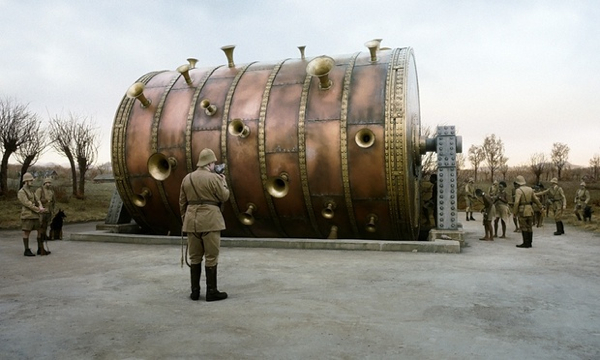Movie review by Greg Carlson
Like hapless novelty salesmen Jonathan (Holger Andersson) and Sam (Nisse Vestblom), filmmaker Roy Andersson clearly just wants to help people have fun. Completing his “Living” trilogy – which also contains the brilliant pair “Songs from the Second Floor” (2000) and “You, the Living” (2007) – “A Pigeon Sat on a Branch Reflecting on Existence” is the set’s piece de resistance and one of the best films of the year. Revisiting Andersson’s ambitious themes, which include observations on class, colonialism, lust, greed, and war, Andersson’s colossal achievement is a memento mori made surprisingly warm by the filmmaker’s desire to laugh with his fellow human beings and not at them.
Better witnessed than described, Andersson’s work nevertheless draws favorable comparisons to Edward Hopper and Samuel Beckett, and cinematic grand masters like Luis Bunuel, Federico Fellini, Stanley Kubrick, and Woody Allen, with strong kinship to the traffic jam insanity of Jean-Luc Godard’s “Weekend” and the pinball connections of Richard Linklater’s “Slacker.” Andrew O’Hehir even suggests that “if Wes Anderson and Lars von Trier tried to write a sitcom together,” it might be something like “Pigeon.” Truly, as has so often been repeated, there is nobody out there making movies quite like Andersson.
Marked by painstakingly composed tableaux, uninterrupted takes with no cut-ins or close-ups, and jet-black comedy alternating with tender poignancy, Andersson’s universe is vast and wondrous. His approach to production is the antithesis of the assembly line factory churning out Hollywood studio fare: almost unbelievably, Andersson designs his sets (which typically heighten and exaggerate the illusion of depth) and then collects dozens of takes of mostly non-professional performers until he sees something he likes. The scenes that end up in the movies are human-scale dioramas – moving and breathing paintings that merit multiple viewings.
Andersson, whose sharp-eyed existentialism complements the anything goes atmospherics contained within his movie world, is so comfortable and in command, viewers readily accept the methodological madness that includes musical numbers, fourth-wall violations, genre assassinations, and time-bending disequilibrium that blurs all borders between dream and reality. Quotidian moments – lovers looking out from a window, two little girls blowing bubbles – share space with mind-melting fantasias like the nightmare showstopper in which wealthy, formally dressed senior citizens are entertained by the music produced from the torture of slaves being cooked in a gigantic, rotating copper cylinder.
Beyond the Laurel and Hardy hijinks of Jonathan and Sam trying to unload their pathetic stock of plastic vampire teeth and cheap rubber “Uncle One-Tooth” masks – a structural thread not too far removed from the misadventures of Kalle the arsonist in “Songs from the Second Floor” – Andersson sticks to his hallmark vignettes. Fans will cite their favorites, and there are no wrong answers in that respect. Memorable contenders include opening bit “Three meetings with death,” the ghoulishly fascinating musical torture chamber, and the anachronistic campaign of King Charles XII (Viktor Gyllenberg). The last, partially glimpsed through windows and in the background, like the business-suited flagellants and the ambulatory apartment of rock and roll newlyweds in the earlier films, confirms Andersson as one of cinema’s irreplaceable treasures.
